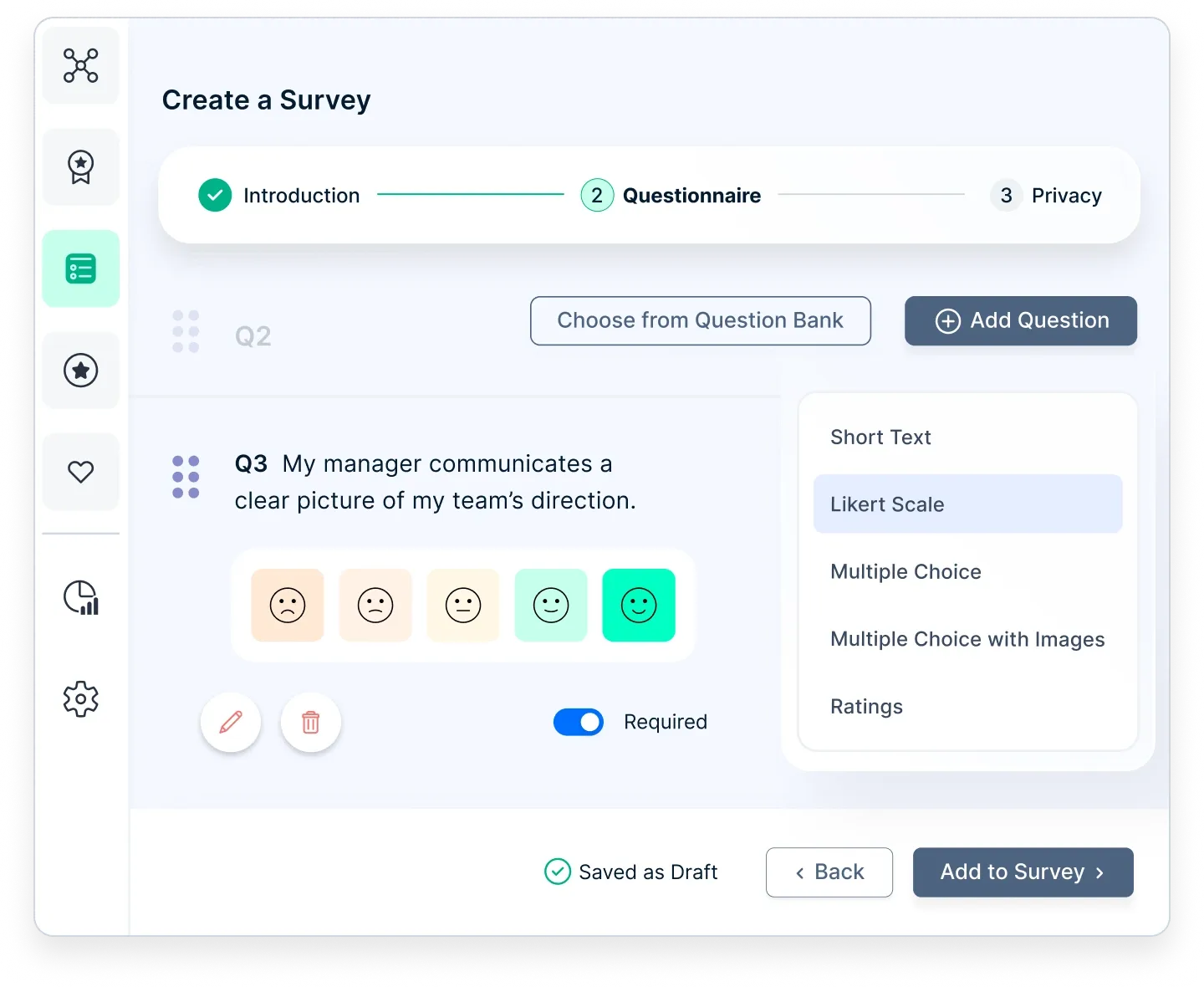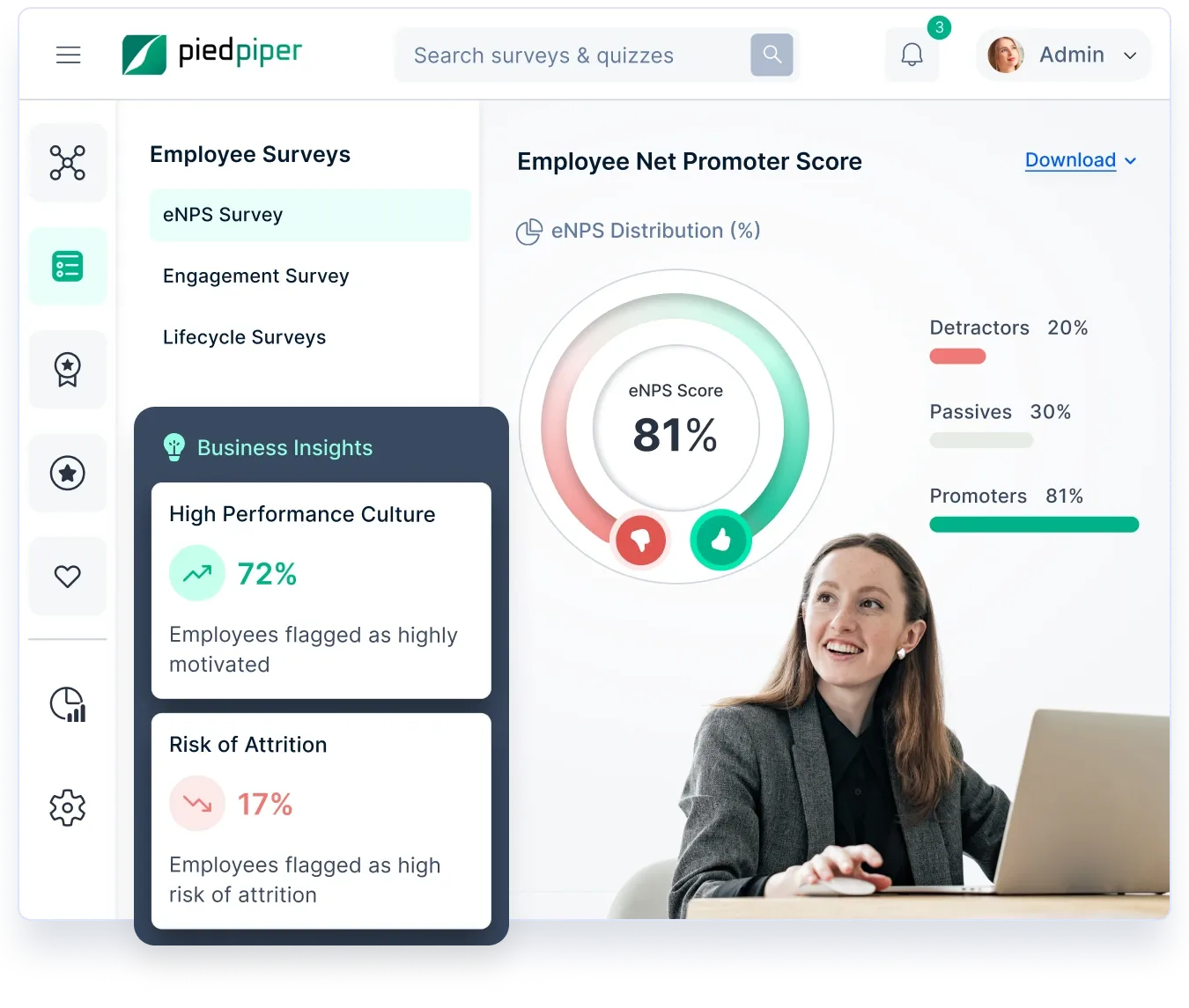Fragen zur Mitarbeiterbefragung: Was man fragen und was man vermeiden sollte [+20 Muss-Fragen]
Die richtigen Fragen bei Umfragen zum Mitarbeiterengagement sind der Schlüssel zum Verständnis der Stimmung am Arbeitsplatz und zur Verbesserung des Engagements. Gut formulierte Fragen liefern verwertbare Erkenntnisse und helfen Unternehmen, die Motivation und Produktivität ihrer Mitarbeiter zu steigern.
Auf dieser Seite
- Regeln für die Gestaltung eines Fragebogens zur Mitarbeiterbefragung bei der Durchführung einer Umfrage
- Erstellung effektiver Fragen für die Mitarbeiterbefragung
- Arten von Fragen zur Mitarbeiterbefragung
- Offene Fragen für Umfragen zum Mitarbeiterengagement
- 20 Beispiele für Fragen zur Mitarbeiterbeteiligung, die Sie stellen müssen
- Arten von Fragen, die Sie in Ihrer Umfrage zum Mitarbeiterengagement vermeiden sollten
- Nutzen Sie Empuls , um Umfragen zum Mitarbeiterengagement mit datengestützten Erkenntnissen zu vereinfachen
- Schlussfolgerung
Der Erfolg eines Unternehmens hängt von vielen Faktoren ab, aber das Engagement der Mitarbeiter ist ein wichtiger Faktor für Produktivität und Wachstum. Engagierte Mitarbeiter sind nicht nur mit ihrer Arbeit zufrieden - sie sind motiviert, engagiert und tragen zum Unternehmenserfolg bei.
Umfragen zum Mitarbeiterengagement helfen, die Stimmung am Arbeitsplatz, die Effektivität der Führung und die Arbeitsmotivation zu messen. Gut strukturierte Fragen bringen Erkenntnisse zutage, die die Arbeitsplatzkultur und das Wohlbefinden der Mitarbeiter verbessern. Doch wie stellt man die richtigen Fragen, um aussagekräftiges Feedback zu erhalten?
Es ist wichtig, zwischen Engagement und Zufriedenheit zu unterscheiden - ein zufriedener Mitarbeiter ist nicht immer engagiert, aber ein engagierter Mitarbeiter ist wahrscheinlich glücklich. Eine sorgfältig konzipierte Umfrage zum Mitarbeiterengagement hilft Unternehmen, herauszufinden, was die Motivation antreibt und wo Verbesserungen erforderlich sind.
Regeln für die Gestaltung eines Fragebogens zur Mitarbeiterbefragung bei der Durchführung einer Umfrage
Es gibt eine Reihe von Regeln, die Sie beachten müssen, bevor Sie eine Umfrage zum Mitarbeiterengagement erstellen:
- Der Befragte sollte wissen, wer die Umfrage durchführt und warum.
- Stellen Sie sicher, dass die Antworten korrekt sind.
- Der Befragte hat den Inhalt der einzelnen Fragen klar verstanden.
- Jede Frage muss eine Bedeutung haben, nicht mehrere Fragen in einer.
- Alle Fragen zum Mitarbeiterengagement müssen so gestaltet sein, dass sie eine vernünftige und genaue Antwort erwarten lassen.
- Alle Fragen zur Mitarbeiterbeteiligung sollten grammatikalisch korrekt sein.
- Der Inhalt der Frage sollte den Befragten nicht beleidigen oder seine Würde herabsetzen.
- Der Interviewer drängt dem Befragten keine Antwortmöglichkeiten auf und verhält sich neutral.
- Die Anzahl der Fragen entspricht dem gesunden Menschenverstand und führt nicht zu einer übermäßigen intellektuellen und psychologischen Überlastung des Befragten.
- Das gesamte System von Fragen und Antworten reicht aus, um die notwendigen Informationen zur Lösung von Forschungsproblemen zu erhalten.
Um eine erfolgreiche Umfrage durchzuführen, müssen Sie sicherstellen, dass die Fragen Ihrer Umfrage zum Mitarbeiterengagement diesen vier Schlüsselelementen entsprechen:
- Sie sind klar, unmissverständlich und pointiert.
- Sie sind neutral formuliert.
- Sie fragen immer nur eine Sache auf einmal.
- Sie fragen nach etwas, das Sie ändern oder verbessern können.
Mit diesen Richtlinien können Sie sicherstellen, dass Sie klare und umsetzbare Daten aus Ihrer Umfrage zum Mitarbeiterengagement erhalten. Wenn Ihre Fragen zum Mitarbeiterengagement für die Umfrage schlecht formuliert sind, sind Sie nach den Antworten möglicherweise verwirrter als vorher!
Wenn Sie Ihre Umfrage zur Mitarbeiterbeteiligung erstellen, sollten Sie darauf achten, dass sie nicht zu lang ist. Natürlich möchten Sie Feedback zu vielen Themen einholen - aber Ihre Mitarbeiter sind bereits mit ihrer Arbeit beschäftigt.
Je länger Sie von den Teilnehmern erwarten, dass sie alles stehen und liegen lassen und Ihre Umfrage beantworten, desto mehr Teilnehmer werden die Umfrage abbrechen, ohne alle Fragen zu beantworten. Kürzer ist effektiver.
Der Inhalt der Fragen bestimmt die Qualität der Erhebung, die Qualität der Arbeit der Fragebögen oder der Interviewer und die Bedingungen der Erhebung.
Tipps zur Formatierung
Auch wenn Sie Ihren Fragebogen nach Belieben gestalten möchten, können Sie mit einigen psychologischen Tricks möglichst objektive Ergebnisse erzielen:
- Es ist besser, die Fragen und Antworten in verschiedenen Schriftgrößen auszudrucken, um sie deutlich voneinander zu unterscheiden.
- Eventuelle Erläuterungen sollten ebenfalls hervorgehoben werden (z. B. kursiv geschrieben).
- Planen Sie ausreichend Platz für die Beantwortung von offenen und halbgeschlossenen Fragen ein.
- Vermeiden Sie Situationen, in denen einige Varianten auf die nächste Seite verschoben werden, da die Befragten sie möglicherweise für weniger wichtig halten.
Erstellung effektiver Fragen für die Mitarbeiterbefragung
Eine Umfrage zur Mitarbeiterzufriedenheit ist eine der besten Möglichkeiten, um herauszufinden, was die Mitarbeiter von ihrer Arbeit halten, ob sie sie als sinnvoll empfinden und wie motiviert sie täglich sind. Es reicht jedoch nicht aus, nur ein paar vage Fragen zu stellen, um das Engagement zu verbessern.
Die Formulierung der richtigen Fragen für Umfragen zum Mitarbeiterengagement ist der Schlüssel zum Sammeln von umsetzbarem Feedback. Der Wortlaut, die Struktur und die Klarheit der Fragen wirken sich auf die Qualität der Antworten aus. Eine gut konzipierte Umfrage hilft dabei, wichtige Schwerpunktbereiche zu ermitteln, z. B. sinkende Produktivität, die Wahrnehmung neuer Initiativen durch die Mitarbeiter oder Reaktionen auf Veränderungen im Unternehmen.
Um genaues und aussagekräftiges Feedback zu gewährleisten:
- Halten Sie die Fragen klar und einfach, um Verwirrung zu vermeiden.
- Bewahren Sie die Anonymität, um ehrliche Antworten zu fördern.
- Konzentrieren Sie sich auf spezifische Faktoren für das Engagement, wie Arbeitszufriedenheit, Unternehmenskultur und Autonomie.
Beispielhafte Fragen können sein:
- Fühlen Sie sich in Ihrer Rolle wertgeschätzt?
- Würden Sie dieses Unternehmen einem Freund empfehlen?
- Finden Sie Ihre Arbeit sinnvoll und herausfordernd?
- Wo kann sich das Unternehmen Ihrer Meinung nach verbessern?
Sobald die Ergebnisse analysiert sind, sollten Sie die wichtigsten Erkenntnisse mit den Mitarbeitern teilen und klare Aktionsschritte festlegen. Eine Umfrage sollte zu echten Verbesserungen führen, das Vertrauen stärken und sicherstellen, dass die Mitarbeiter sehen, dass ihr Feedback etwas bewirkt.

Fördern Sie das Mitarbeiterengagement mit umsetzbaren Erkenntnissen
Entwerfen Sie individuelle Mitarbeiterbefragungen, analysieren Sie Antworten mit KI und treffen Sie datengestützte Entscheidungen zur Verbesserung der Arbeitsplatzkultur - alles mit Empuls.
Arten von Fragen zur Mitarbeiterbefragung
Angenommen, Sie gehören nicht zu den Fachleuten, die Aufsätze für Einwanderer schreiben. In diesem Fall wissen Sie wahrscheinlich nicht, dass Sie verschiedene Arten von Fragen in Ihrem Fragebogen verwenden können.
Es gibt zwei Arten von Fragen zur Mitarbeiterbeteiligung:
1. Geschlossene Fragen zur Mitarbeiterbefragung
Geschlossene Fragen sind Fragen, die eine oder mehrere Antwortmöglichkeiten enthalten. Geschlossene Fragen werden verwendet, wenn es darum geht, das Bewusstsein einer Person für ein bestimmtes Problem aufzudecken oder bestimmte Aspekte zu beschreiben.
Anforderungen für die Zusammenstellung geschlossener Fragen:
- Die Liste der Antworten sollte erschöpfend sein. Es ist notwendig, alle möglichen Antworten im Voraus zu bedenken.
- Es ist wünschenswert, dass die am wenigsten wahrscheinlichen Antworten zu den ersten gehören.
- Alle Antwortmöglichkeiten müssen auf der gleichen Ebene der Spezifität aufrechterhalten werden.
Geschlossene Fragen werden in der Regel von den Befragten aus einer bestimmten Gruppe von Antworten gestellt. Zum Beispiel Fragen, die nur mit "Ja" oder "Nein" beantwortet werden können. Dazu können auch Fragen mit einer bestimmten Anzahl von Multiple-Choice-Antworten gehören.
Geschlossene Fragen sind vorteilhaft, wenn Sie eine Umfrage in großem Maßstab durchführen müssen. Das liegt daran, dass ihre Beantwortung weniger Zeit in Anspruch nimmt. Ein weiterer Vorteil von geschlossenen Fragen ist, dass sie nicht kompliziert sind.
Die Teilnehmer können leicht verstehen, was gefragt wird, und die relevanteste Antwort auswählen. Diese Fragen eignen sich hervorragend, um allgemeine Einblicke zu gewinnen, erlauben es den Teilnehmern aber nicht, tiefer gehende Antworten und Gedanken zu äußern.
Halbgeschlossene Fragen bieten die Möglichkeit, sich den vorgegebenen Antworten zu entziehen und Ihre Version in einer eigenen Zeile anzugeben. Direkte Fragen sind persönlich formuliert (z. B. "Gefällt Ihnen Ihre Arbeit?").
Eine indirekte Frage ermöglicht es dem Befragten, sich aus der Position der Gruppe, des Teams, zu äußern; sie wird verwendet, wenn das persönliche Leben des Befragten betroffen ist, seine Einstellung zu negativen Phänomenen.
2. Offene Fragen zur Mitarbeiterbefragung
Bei offenen Fragen werden den Befragten die möglichen Antworten nicht vorgegeben, sondern sie müssen die Antworten selbst formulieren und aufschreiben.
Es ist besser, offene Fragen zu verwenden, wenn der Befragte seine Meinung begründen und erklären muss, warum er so denkt.
Offene Fragen in Umfragen zum Mitarbeiterengagement sind Fragen, die nicht mit einem einfachen "Ja" oder "Nein" beantwortet werden können. Bei diesen Fragen müssen die Teilnehmer ihre Antworten erläutern und erklären.
Offene Fragen zur Mitarbeiterbeteiligung werden in der Regel verwendet, um die Antworten und Rückmeldungen der Mitarbeiter zu beschreiben und ihre Gefühle und/oder Bedenken zu äußern.
Sie geben den Teilnehmern die Freiheit, so zu antworten, wie sie es möchten, anstatt ihre Antworten einzuschränken.
3. Abgeschlossene vs. offene Fragen
Geschlossene Fragen haben zwar viele Vorteile, z. B. sind sie zeitsparend und einfach zu beantworten, aber sie schränken auch stark ein, da die Befragten nur aus einer Reihe von Antworten auswählen können.
Aus diesem Grund ist es besser, offene Fragen für Umfragen zum Mitarbeiterengagement zu verwenden. Sie ermöglichen es Ihren Mitarbeitern, ihre Gedanken und Meinungen besser auszuarbeiten und zu artikulieren.
Da Sie sich über offene und geschlossene Fragen im Klaren sein müssen, sollten Sie bedenken, dass Umfragen zum Mitarbeiterengagement sowohl geschlossene als auch offene Fragen enthalten müssen.
Auf diese Weise wird sichergestellt, dass Sie eine umfassende Messung des Engagements Ihrer Mitarbeiter erhalten.
Offene Fragen für Umfragen zum Mitarbeiterengagement
Um einen besseren Einblick zu erhalten, wie Ihr Unternehmen besser werden kann und Mitarbeiterzufriedenheit verbessernfinden Sie hier fünf offene Fragen zum Mitarbeiterengagement, die Sie in Ihre Umfrage zum Mitarbeiterengagement aufnehmen können.
1. Wie kann das Unternehmen die Dinge verbessern?
Dies ist eine der wichtigen, offenen Fragen zum Engagement, da sie es den Arbeitgebern ermöglicht zu erkennen, womit die Mitarbeiter im Unternehmen nicht ganz zufrieden sind.
Sie gibt Aufschluss über die Bereiche, die verbessert werden müssen, damit der Arbeitsplatz für die Mitarbeiter besser ist. Es ist wichtig, einen Arbeitsplatz zu schaffen, an dem sich Ihre Mitarbeiter wohlfühlen, sich wohlfühlen, motiviert sind und sich wohlfühlen.
Mit den Antworten auf diese Frage können Sie den Arbeitsplatz verbessern, die Arbeitsleistung verbessern.
2. Auf welche Weise erkennt Ihr Vorgesetzter/Arbeitgeber die Arbeit an, die Sie für das Unternehmen leisten?
Bei dieser Frage geht es um die Anerkennung und darum, ob sich Ihr Mitarbeiter anerkannt fühlt oder nicht. Haben sie das Gefühl, dass sie für ihre Arbeit belohnt werden?
Es ist wichtig, dass Ihre Mitarbeiter das Gefühl haben, dass ihre harte Arbeit nicht unbemerkt bleibt. Andernfalls riskieren Sie, dass Ihre Mitarbeiter völlig unmotiviert und damit unproduktiv werden. Wir alle wissen, dass Anerkennung und Belohnung der Arbeit das beste und erfüllendste Gefühl am Arbeitsplatz ist.
Unternehmen mit guten Anerkennungsprogrammen für Mitarbeiter können die Mitarbeiterbindung verbessern und verzeichnen eine 31% geringere freiwillige Fluktuation Rate!
Anhand dieser Frage können Sie also erkennen, wo Sie bei der Anerkennung und Belohnung der harten Arbeit Ihrer Mitarbeiter richtig oder falsch liegen.
3. Welche drei Wörter oder Sätze beschreiben die Kommunikation innerhalb Ihres Teams am besten?
Diese Frage ist wichtig, da sie die Zusammenarbeit und Dynamik von Teams untersucht. Kollaboration und effektive Kommunikation zwischen den Mitarbeitern eines Teams und den Arbeitgebern sind für ein produktives und motiviertes Arbeitsumfeld unerlässlich.
Kommunikation ist ein wichtiger Faktor für das Engagement und ein Schlüsselfaktor für Produktivität, Motivation und Mitarbeiterbindung. Mit dieser Frage können Sie herausfinden, was Ihre Mitarbeiter über die von Ihnen eingerichteten Kommunikationssysteme denken.
Sie können Ihnen auch eine Idee zur Verbesserung dieser Kommunikationssysteme geben. Schlechte Kommunikation ist frustrierend und ein entscheidender Faktor für eine hohe Mitarbeiterfluktuation.
Es wäre also am besten, eine gute Kommunikation und ein gutes Engagement zu fördern, um dies zu vermeiden.
4. Inwiefern gibt Ihnen das Unternehmen das Gefühl, geschätzt zu werden?
Es ist von entscheidender Bedeutung, dass sich Ihre Mitarbeiter wertgeschätzt und anerkannt fühlen. Wenn sich Ihre Mitarbeiter wertgeschätzt fühlen, werden sie dem Unternehmen eher treu bleiben - auch wenn einige Dinge im Unternehmen nicht perfekt sind. Auf diese Weise können Sie auch die Mitarbeiterfluktuation verringern.
Mitarbeiter fühlen sich geschätzt und gewürdigt zu werden kann zu einer höheren Arbeitszufriedenheit und Leistungssteigerung führen. Diese Frage ist also eine der besten Möglichkeiten, um festzustellen, ob sich Ihre Mitarbeiter wertgeschätzt fühlen.
Nachdem Sie gesehen haben, was Ihre Mitarbeiter sagen, können Sie die entsprechenden Änderungen vornehmen, damit Ihre Mitarbeiter wissen, dass Sie sie schätzen. Selbst ein einfaches "Dankeschön" trägt wesentlich zur Mitarbeiterzufriedenheit bei. Studien zeigen, dass 85 % der Mitarbeiter mit dieser einfachen Geste der Wertschätzung zufrieden wären.
5. Welche Art von Feedback erhalten Sie von Ihrem Managementteam?
Nützliches und produktives Feedback ist wichtig für die Entwicklung Ihrer Mitarbeiter im Unternehmen. Es ist, offen gesagt, eines der besten Dinge, die Arbeitgeber anbieten können.
Feedback ist nützlich, weil es den Mitarbeitern hilft, aus ihren Fehlern zu lernen und Vertrauen aufzubauen. Konstruktives Feedback klärt auch die Erwartungen, so dass Ihre Mitarbeiter nicht im Unklaren darüber sind, was sie zu tun haben.
Diese Frage ist wichtig, da Sie den Mitarbeitern die Möglichkeit geben, über das erhaltene Feedback nachzudenken und festzustellen, ob es ihnen nützt. Auf diese Weise können Sie feststellen, ob die Mitarbeiter kein hilfreiches Feedback erhalten.
Oder Ihre Mitarbeiter finden, dass das Feedback, das sie erhalten, zu selten oder sogar zu hart ist. Diese Erkenntnisse werden Ihnen helfen, Ihre Feedback-Methoden zu verbessern, um besser zu werden und Ihre Fähigkeiten zu entwickeln.
20 Beispiele für Fragen zur Mitarbeiterbeteiligung, die Sie stellen müssen
Jetzt kommen wir zu den guten Dingen - den einfachen, aber effektiven Fragen, die Sie in Ihre Umfrage zum Mitarbeiterengagement aufnehmen müssen.
Sie müssen nicht alle aufführen; Sie können sicherlich weitere hinzufügen, die zu den Prioritäten Ihrer Organisation passen. Aber diese sollten Ihnen einen guten Start für die Erstellung Ihrer Umfrage ermöglichen.
Hier finden Sie eine Liste der besten Fragen für die Umfrage zum Mitarbeiterengagement.
1. Würden Sie [Unternehmen] als einen großartigen Arbeitsplatz empfehlen?
Wenn Ihre Mitarbeiter ihren Freunden und Verwandten empfehlen, in Ihrem Unternehmen zu arbeiten, spricht das für ihre Wertschätzung Ihres Unternehmens.
2. Fühlen Sie sich bei der Arbeit gestärkt?
Wenn die Mitarbeiter das Gefühl haben, dass sie ihre Arbeit ohne Mikromanagement erledigen können, fühlen sie sich autonom und vertrauenswürdig - und das führt zu einem höheren Engagement.
3. Freuen Sie sich jeden Morgen darauf, zur Arbeit zu kommen?
Wenn Mitarbeiter morgens nur ungern zur Arbeit kommen, ist das ein Zeichen dafür, dass an Ihrem Arbeitsplatz etwas nicht stimmt. Das ist ein wichtiger Faktor für das Gefühl der Unzufriedenheit.
4. Planen Sie, auch in zwei Jahren noch in diesem Unternehmen zu arbeiten?
Engagierte Mitarbeiter neigen nicht dazu, sich aktiv nach anderen Aufgaben umzusehen - wenn Ihre Mitarbeiter nach einem Ausweg suchen, müssen Sie schnell etwas unternehmen.
5. Fühlen Sie sich mit den Zielen des Unternehmens im Einklang?
Wenn Mitarbeiter das Gefühl haben, dass sie auf ein klares Ziel und den Rest des Unternehmens hinarbeiten, haben sie das Gefühl, zu etwas Größerem als sich selbst beizutragen - und dieses Gefühl fördert das Engagement. Es hilft den Mitarbeitern, sich auf das "Warum" zu konzentrieren.
6. Kümmert sich Ihr Vorgesetzter um Sie als Person?
Unser direkter Vorgesetzter hat einen so großen Einfluss auf unseren Arbeitstag. Mitarbeiter, die sich von ihren Vorgesetzten umsorgt fühlen, sind in der Regel engagierter.
7. Denken Sie, dass das Managementteam transparent ist?
Wenn die Mitarbeiter das Gefühl haben, dass sie den Aussagen ihrer Führungskräfte nicht vertrauen können. Dieses Misstrauen und die fehlende Verbindung können zu Unzufriedenheit und geringerem Engagement führen.
8. Haben Sie das Gefühl, dass Ihr Vorgesetzter Ihre Meinung schätzt?
Es ist wichtig, das Gefühl zu haben, dass man sich bei der Arbeit äußern und seinem Vorgesetzten gegenüber Probleme oder Lösungen ansprechen kann. Fühlen sich Ihre Mitarbeiter dabei sicher?
9. Haben Sie eine gute Arbeitsbeziehung zu Ihren Kollegen?
Seien wir ehrlich - wir verbringen einen Großteil unseres Lebens bei der Arbeit, und unsere Kollegen gehören zu den Menschen, mit denen wir die meiste Zeit verbringen. Wenn Mitarbeiter das Gefühl haben, dass ihr Arbeitsplatz voller Machtkämpfe, Konkurrenzdenken oder mangelndem Vertrauen ist, kann das entmutigend und stressig sein.
10. Haben Sie das Gefühl, dass Sie bei der Arbeit ganz Sie selbst sein können?
Wenn Mitarbeiter das Gefühl haben, einen Teil von sich am Arbeitsplatz verstecken zu müssen (z. B. ihr Geschlechtspronomen), oder wenn sie das Gefühl haben, dass ihre Mitarbeiter oder Führungskräfte diesen wesentlichen Teil nicht akzeptieren, können sie sich zunehmend unzufrieden fühlen und einen Arbeitsplatz suchen, an dem sie sich besser akzeptiert fühlen.
11. Glauben Sie, dass sich das Unternehmen um Ihr körperliches und geistiges Wohlbefinden kümmert?
Sich am Arbeitsplatz gut aufgehoben zu fühlen, ist ein tolles Gefühl. Wenn die Mitarbeiter das Gefühl haben, dass sich ihr Unternehmen um ihr körperliches Wohlbefinden kümmert, z. B. durch eine sichere und bequeme Arbeitsumgebung, und um ihr geistiges Wohlbefinden, indem es dafür sorgt, dass sie genügend Freizeit haben und Burnout vermieden wird, trägt dies zu einer weniger gestressten, engagierteren Belegschaft bei.
12. Fühlen Sie sich für Ihre harte Arbeit und Ihre Erfolge in Ihrem Beruf anerkannt?
Die Anerkennung und Belohnung von Mitarbeitern für gut geleistete Arbeit, sei es bei einem großen Projekt oder einer kleinen Aufgabe, ist von entscheidender Bedeutung, um ihr Engagement zu erhalten. Denn wenn man hart arbeitet, aber keine Anerkennung erhält, ist das eine wirklich entmutigende Erfahrung.
Wenn Sie nicht wissen, wie oft sich Ihre Mitarbeiter anerkannt fühlen, wissen Sie auch nicht, welche Schritte Sie unternehmen können, um die Situation zu verbessern (z. B. durch den Einsatz von Empuls zu erkennen und zu belohnen, einfach und macht Spaß).
13. Haben Sie einen besten Freund bei der Arbeit?
Diese Frage stammt aus dem Goldstandard der Umfragen zum Mitarbeiterengagement: dem Gallup Q12-Fragebogen zum Mitarbeiterengagement. Sie mag ein wenig seltsam erscheinen, aber Gallup stellt sie, weil sie einen signifikanten Zusammenhang gefunden haben zwischen dem Vorhandensein eines besten Freundes oder einer besten Freundin am Arbeitsplatz und erhöhtem Engagement im Job.
14. Werden Sie für Ihren Beitrag zu Ihrem Team angemessen anerkannt?
Wenn Ihr Team das Glück hat, einen Superstar zu haben, wird dieser dann für seinen individuellen Beitrag anerkannt? Oder werden sie meist nur mit dem Rest des Teams in einen Topf geworfen? Diese Erfahrung kann frustrierend sein, wenn leistungsstarke Mitarbeiter das Gefühl haben, dass sie oft für schwache Mitarbeiter einspringen müssen.
15. Sind Sie mit den Leistungen, die das Unternehmen bietet, zufrieden?
Die Bandbreite der Leistungen, die Arbeitnehmer von ihren Arbeitgebern erwarten, ist gewachsen - einige Unternehmen bieten neue Vergünstigungen wie Haustierversicherungen, Wellness-Center im Büro und vieles mehr. Wie denken Ihre Mitarbeiter, dass Sie auf dem neuesten Stand sind?
16. Inspiriert Sie Ihr Team, Ihre beste Arbeit zu leisten?
Die Menschen, die uns tagtäglich umgeben, können uns zu neuen Höchstleistungen anspornen - oder sie können uns mit ihrer schlechten Einstellung und ihrer faulen Arbeitsweise herunterziehen. Wie denken Ihre Mitarbeiter über ihre engen Kollegen?
17. Haben die Führungskräfte bei [Unternehmen] eine Vision vermittelt, die Sie motiviert?
Spüren Ihre Mitarbeiter eine klare Verbindung zwischen ihrer Arbeit und der Vision und den Zielen Ihres Unternehmens als Ganzes? Wenn es Ihren Führungskräften an dieser Art von Kommunikation mangelt, verpassen Sie möglicherweise eine Chance, das Engagement und die Ergebnisse zu steigern.
18. Haben Sie Zugang zu den Werkzeugen und Technologien, die Sie für Ihre Arbeit benötigen?
Sicher, Sie denken vielleicht, dass Sie Ihren Mitarbeitern alles zur Verfügung stellen, was sie für ihre Arbeit brauchen. Aber Sie sind eine Führungskraft - Sie sind nicht bei der täglichen Arbeit dabei. Wenn Sie nachsehen, ob etwas fehlt, damit die Mitarbeiter ihre Arbeit bestmöglich erledigen können, kann dies zu großen Produktivitätssteigerungen führen.
19. Wissen Sie, was Sie tun müssen, um in Ihrer Rolle erfolgreich zu sein?
Mitarbeiter können nur dann erfolgreich sein, wenn sie wissen, was sie tun sollen. Dies mag einfach erscheinen, aber es kann eine überraschend große Diskrepanz zwischen den Vorstellungen der Mitarbeiter über ihre Rolle und den Erwartungen der Manager und Führungskräfte bestehen.
20. Glauben Sie, dass es in diesem Unternehmen gute Karrieremöglichkeiten für Sie gibt?
Einer der Hauptgründe, warum großartige Mitarbeiter Ihr Unternehmen verlassen, ist, dass sie keinen soliden, vielversprechenden Karriereweg vor sich sehen. Ist dies ein Problem, das Sie angehen müssen? Finden Sie es heraus, indem Sie Ihre Mitarbeiter direkt befragen.

Kostenlose Umfragevorlagen zum Erfassen der Mitarbeiterstimmung herunterladen
Nutzen Sie die von Experten entworfenen Vorlagen, um das Engagement Ihrer Mitarbeiter, die Arbeitszufriedenheit und die Arbeitsplatzkultur zu erfassen. Erhalten Sie sofortigen Zugriff auf die Vorlagen, die Ihren Anforderungen entsprechen.
Arten von Fragen, die Sie in Ihrer Umfrage zum Mitarbeiterengagement vermeiden sollten
Eine gut konzipierte Umfrage zum Mitarbeiterengagement hilft Unternehmen, aussagekräftige Erkenntnisse zu gewinnen. Schlecht strukturierte Fragen können jedoch zu irreführenden Antworten, Umfragemüdigkeit oder ungenauen Daten führen. Im Folgenden finden Sie sieben Arten von Fragen, die Sie bei der Gestaltung Ihrer Umfrage vermeiden sollten.
1. Leitende oder voreingenommene Fragen
Fragen, die die Mitarbeiter zu einer bestimmten Antwort drängen, können die Umfrageergebnisse verzerren. Fragen Sie statt "Wie zufrieden sind Sie mit unserer exzellenten Führung?" lieber "Wie beurteilen Sie die Unterstützung der Führung im Unternehmen?"
2. Vage oder zweideutige Fragen
Unklare Formulierungen verwirren die Mitarbeiter und führen zu uneinheitlichen Antworten. Anstelle von "Fühlen Sie sich bei der Arbeit unterstützt?" sollten Sie angeben : "Erhalten Sie bei Bedarf rechtzeitig Unterstützung von Ihrem Vorgesetzten?"
3. Doppelläufige Fragen
Hier werden mehrere Themen in einer Frage zusammengefasst, was eine genaue Beantwortung erschwert. Vermeiden Sie die Frage "Fühlen Sie sich wertgeschätzt und haben Sie Entwicklungsmöglichkeiten?" - teilen Siesie in zwei separate Fragen auf.
4. Zu viele offene Fragen
Offene Fragen bieten zwar reichhaltige Einblicke, aber zu viele können die Mitarbeiter überfordern und die Beteiligung verringern. Verwenden Sie sie sparsam und gleichen Sie sie mit skalierten oder Multiple-Choice-Fragen aus.
5. Negativ formulierte Fragen
Negative Formulierungen können Verwirrung stiften. Fragen Sie statt "Fühlen Sie sich von Ihrem Vorgesetzten nicht unterstützt?" lieber "Wie beurteilen Sie den Grad der Unterstützung durch Ihren Vorgesetzten?"
6. Fragen, die in die Privatsphäre eindringen
Den Mitarbeitern ist es möglicherweise unangenehm, allzu persönliche Fragen zu beantworten. Vermeiden Sie alles, was mit privaten Angelegenheiten zu tun hat, die nichts mit der Einstellung zu tun haben, wie z. B. persönliche Überzeugungen oder Gesundheitszustände.
7. Übermäßig lange oder komplexe Fragen
Langatmige oder technische Fragen verringern das Engagement und können dazu führen, dass die Umfrage abgebrochen wird. Halten Sie die Fragen kurz, klar und prägnant, um hohe Beantwortungsquoten zu gewährleisten.
Eine gut gestaltete Umfrage zum Mitarbeiterengagement konzentriert sich auf Klarheit, Neutralität und Relevanz. Die Vermeidung dieser Fehler führt zu genaueren Erkenntnissen und umsetzbarem Feedback, das zur Verbesserung der Arbeitsplatzkultur und der Mitarbeiterzufriedenheit beiträgt.
Nutzen Sie Empuls , um Umfragen zum Mitarbeiterengagement mit datengestützten Erkenntnissen zu vereinfachen

Es ist wichtig, die richtigen Fragen für die Mitarbeiterbefragung zu formulieren, aber genauso wichtig ist es, die Antworten effektiv zu erfassen und zu analysieren. Empuls macht diesen Prozess nahtlos, indem es eine leistungsstarke Plattform für Mitarbeiterbefragungen anbietet, die Unternehmen dabei hilft, das Feedback ihrer Mitarbeiter in Echtzeit zu messen, zu analysieren und darauf zu reagieren.
Mit KI-gestützten Analysen, automatisierten Pulsbefragungen und anonymen Feedback-Optionen stellt Empuls sicher, dass Sie genaue und umsetzbare Erkenntnisse sammeln, ohne die Mitarbeiter zu überfordern. Ganz gleich, ob Sie anpassbare Vorlagen oder ausführliche Berichte benötigen, Empuls hilft Ihnen bei der Gestaltung von Umfragen, die die Stimmung am Arbeitsplatz erfassen.
Mit Empuls erhalten Sie,
- Gebrauchsfertige Umfragevorlagen für den schnellen Einstieg.
- KI-gesteuerte Stimmungsanalyse für tiefere Einblicke.
- Anonyme und vertrauliche Umfragen, um ehrliches Feedback zu fördern.
- Echtzeit-Dashboards zur Verfolgung von Engagement-Trends und Verbesserungen.
- Automatisierte Planung von Umfragen zur Gewährleistung eines kontinuierlichen Mitarbeiter-Feedbacks.
Mit Empuls gehen Engagement-Befragungen über die reine Datenerhebung hinaus - sie werden zu einem strategischen Instrument zur Verbesserung der Arbeitsplatzkultur und zur Steigerung der Mitarbeiterzufriedenheit.
Schlussfolgerung
Eine Umfrage zum Mitarbeiterengagement ist nur dann effektiv, wenn sie die richtigen Fragen stellt. Durchdachte, gut strukturierte Fragen tragen dazu bei, echte Erkenntnisse zu gewinnen und sicherzustellen, dass sich die Mitarbeiter gehört und wertgeschätzt fühlen.
Das Einholen von Feedback ist jedoch nur der erste Schritt. Die transparente Weitergabe der Ergebnisse und die Ergreifung umsetzbarer Maßnahmen schaffen Vertrauen und fördern die künftige Beteiligung. Wenn die Mitarbeiter sinnvolle Veränderungen sehen, steigt das Engagement.
Durch die Anwendung bewährter Verfahren können Unternehmen eine Kultur der kontinuierlichen Verbesserung fördern, in der die Mitarbeiter motiviert, verbunden und dem Erfolg verpflichtet bleiben.
FAQs
1. Was sind die besten Fragen für eine Umfrage zum Mitarbeiterengagement?
Die besten Fragen beziehen sich auf Arbeitszufriedenheit, Führung, Arbeitsplatzkultur und Entwicklungsmöglichkeiten. Beispiele hierfür sind "Fühlen Sie sich bei der Arbeit wertgeschätzt?" und "Was würde Ihr allgemeines Engagement verbessern?"
2. Wie oft sollte eine Umfrage zum Mitarbeiterengagement durchgeführt werden?
Umfragen sollten jährlich oder vierteljährlich durchgeführt werden, je nach den Bedürfnissen der Organisation. Pulsumfragen können auch häufiger durchgeführt werden, um Trends im Engagement zu verfolgen.
3. Wie ermutigen Sie Ihre Mitarbeiter zur Teilnahme an Umfragen zum Engagement?
Gewährleisten Sie Anonymität, erklären Sie den Zweck der Umfrage und zeigen Sie auf, wie frühere Rückmeldungen zu Verbesserungen geführt haben. Eine klare Kommunikation und die Unterstützung durch die Leitung fördern die Teilnahme ebenfalls.
4. Was ist der Unterschied zwischen Mitarbeiterzufriedenheit und Engagement?
Zufriedenheit spiegelt die allgemeine Zufriedenheit am Arbeitsplatz wider, während Engagement die Motivation, das Engagement und die emotionale Beteiligung an der Arbeit misst. Engagierte Mitarbeiter gehen über die grundlegende Zufriedenheit hinaus.
5. Wie viele Fragen sollte eine Umfrage zum Mitarbeiterengagement enthalten?
Eine ausgewogene Umfrage sollte 10-20 prägnante, relevante Fragen enthalten. Zu viele Fragen können zu Ermüdungserscheinungen führen, während zu wenige keine aussagekräftigen Erkenntnisse liefern.
6. Sollten Umfragen zum Mitarbeiterengagement anonym sein?
Ja, Anonymität fördert ehrliches Feedback, was zu genaueren und umsetzbaren Erkenntnissen führt. Die Mitarbeiter sollten sich sicher fühlen, wenn sie ihre wahre Meinung sagen.
7. Wie analysieren Sie die Ergebnisse einer Umfrage zum Mitarbeiterengagement?
Suchen Sie nach Mustern und Trends in den Antworten, segmentieren Sie die Daten nach Abteilungen oder Funktionen und vergleichen Sie die Ergebnisse mit früheren Umfragen, um Verbesserungen oder Bereiche zu ermitteln, die Aufmerksamkeit erfordern.
8. Was sollte nach dem Sammeln der Ergebnisse der Umfrage zum Mitarbeiterengagement getan werden?
Teilen Sie die wichtigsten Ergebnisse transparent mit, diskutieren Sie sie mit den Mitarbeitern und führen Sie gezielte Verbesserungen durch. Die Umsetzung von Maßnahmen schafft Vertrauen und erhöht die Beteiligung an zukünftigen Umfragen.













